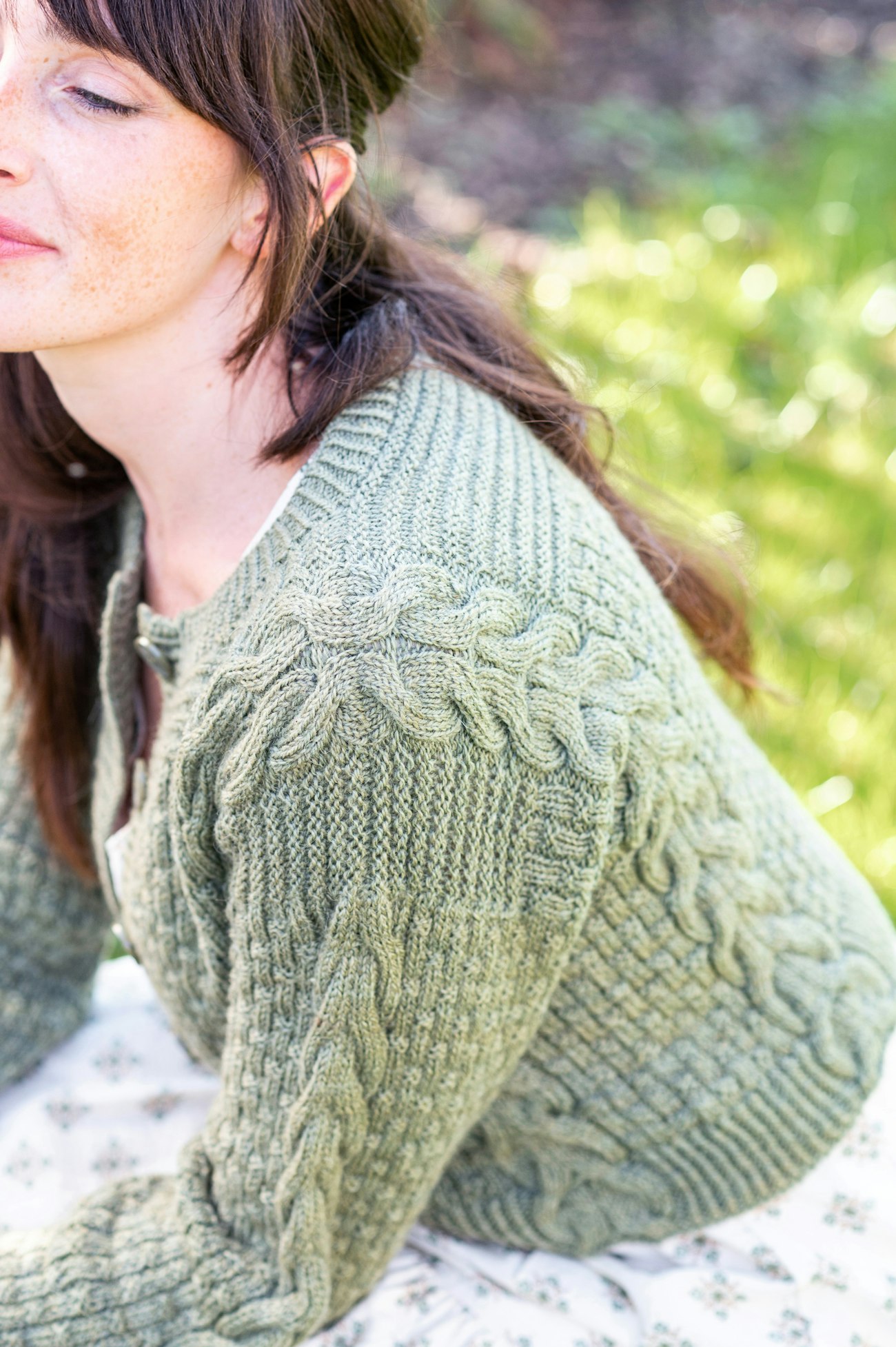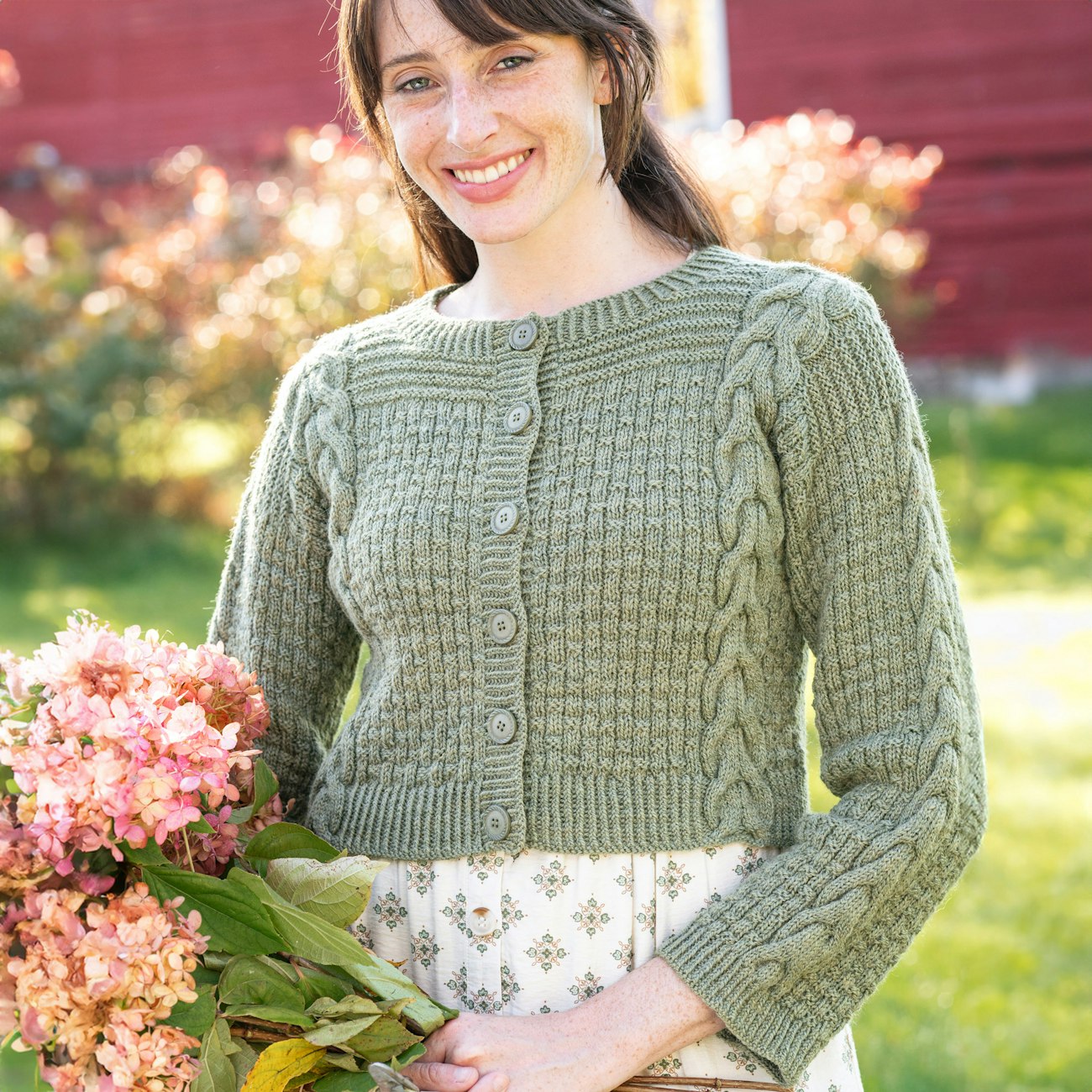Subscriber Exclusive
A Hug from the Flock: Knit the Wee Cardi
Top-down construction, drop sleeves, and rich texture celebrate the unique yarn from a special farm.
Top-down construction, drop sleeves, and rich texture celebrate the unique yarn from a special farm. <a href="https://farmfiberknits.com/wee-cardi/">Continue reading.</a>
https://farmfiberknits.com/cdn-cgi/image/format=auto/https://www.datocms-assets.com/101500/1715303801-22021_zucker20231026-header.jpg?auto=format&w=900
Hand-dyed with onion skin, marigold, and indigo, the lovely green shade of this yarn is a beautiful reminder of my visit to Wing and a Prayer Farm. It was early summer, and dye flowers were blooming in every imaginable corner. I greeted donkeys, goats, alpacas, and the friendliest sheep I have ever met, and my sheep-farm-visiting wishes and dreams all came true.
Cropped and boxy with full sleeves, the silhouette of the Wee Cardi takes on a retro feel. Choose a size with about 4 inches of positive ease for a loose fit, make a smaller size with less ease for a tailored fit, or even go a size or two larger for an oversized result.
The cardigan is constructed seamlessly, from the top down, beginning with the back. The back neck is worked straight across (although it appears shaped in the finish garment due to the magic contracting qualities of the welted stitch). Once you’ve knit to the bottom of the armholes, the back stitches are put on hold, and stitches for the fronts are picked up and knit down to the same length. The yoke of welted stitch makes the front neck shaping easy. Joining the fronts and the back into one piece for the lower body eliminates any side seaming, and once the woven pattern has been introduced, it is worked even to the lower edge, so there is no shaping in the woven pattern until you get to the sleeve decreases. Stitches for the sleeves are picked up around the armhole openings and worked in the round down to the cuff.

I’ve taken a bit of a loosey-goosey approach to the use of the woven pattern chart, with instructions for how to mark the stitch you end on when establishing the pattern on a RS row so you can start the pattern on the following WS row with the same stitch. This approach should be much easier to follow than finding your starting and ending points amongst the numerous separate charts that would be required to specify exact ending points for each of the sections for all nine sizes. If you can read the knits and purls of your knitting, the pattern is easy to knit by sight. You’ll get a good idea of how it works once you’ve knit a gauge swatch in the pattern stitch.
The nature of hand-dyed yarns means that each skein has a variance in color, and the skeins may have differences in shade and tone as well. Alternating skeins every two rows helps soften any striping that may occur. To be honest, I worked with one skein for the welted stitch portions of the front and back and another skein for each sleeve and didn’t bother alternating skeins for the neck and fronts bands either. I did alternate skeins for the woven stitch portions of the back and fronts.
I was lucky to find the perfect shade of green in my button collection. While vacationing in Maine, I picked up a beautiful set of wooden buttons that would have looked great, but I couldn’t resist the perfect match of the antique buttons.

MATERIALS
Yarn Wing and a Prayer Farm Taconic Twist (100% wool [Merino, Wensleydale, Cotswold, mohair]; 268 yd (245 m)/100 g; sportweight); color onion skin, marigold, and indigo; 5 (5, 6, 6, 7) (7, 7, 8, 8) hanks.
Needles Size 5 (3.75 mm) 16" and 32" (40 and 80 cm) circular needles (cir) and set of double-pointed needles (dpn); size 3 (3.25 mm) 16" and 32" (40 and 80 cm) cir and set of dpns. Adjust needle size if necessary to obtain the correct gauge.
Notions Cable needle (cn); stitch marker (m); removable markers; stitch holders (may substitute scrap yarn or spare needles); tapestry needle; six 7/8" buttons.
Gauge 26 sts and 35 rows/rnds = 4" (10 cm) in pattern from Woven Stitch chart using larger needles, blocked; 21 sts of Double Cable chart measure 2½" (6.4 cm) wide using larger needles, blocked.
Finished Size 34¼ (38¼, 42, 45¼, 49¼) (53, 56½, 60¼, 64)" (87 [97, 106.5, 115, 125] [134.5, 143.5, 153, 162.5] cm) chest circumference, buttoned, including 1" (2.5 cm) overlapped front bands. Shown in size 38¼", modeled with 3¼" ease.
Visit farmfiberknits.com/abbreviations for terms you don’t know.
SUBSCRIBER EXCLUSIVE
Hand-dyed with onion skin, marigold, and indigo, the lovely green shade of this yarn is a beautiful reminder of my visit to Wing and a Prayer Farm. It was early summer, and dye flowers were blooming in every imaginable corner. I greeted donkeys, goats, alpacas, and the friendliest sheep I have ever met, and my sheep-farm-visiting wishes and dreams all came true.
Cropped and boxy with full sleeves, the silhouette of the Wee Cardi takes on a retro feel. Choose a size with about 4 inches of positive ease for a loose fit, make a smaller size with less ease for a tailored fit, or even go a size or two larger for an oversized result.
The cardigan is constructed seamlessly, from the top down, beginning with the back. The back neck is worked straight across (although it appears shaped in the finish garment due to the magic contracting qualities of the welted stitch). Once you’ve knit to the bottom of the armholes, the back stitches are put on hold, and stitches for the fronts are picked up and knit down to the same length. The yoke of welted stitch makes the front neck shaping easy. Joining the fronts and the back into one piece for the lower body eliminates any side seaming, and once the woven pattern has been introduced, it is worked even to the lower edge, so there is no shaping in the woven pattern until you get to the sleeve decreases. Stitches for the sleeves are picked up around the armhole openings and worked in the round down to the cuff.

I’ve taken a bit of a loosey-goosey approach to the use of the woven pattern chart, with instructions for how to mark the stitch you end on when establishing the pattern on a RS row so you can start the pattern on the following WS row with the same stitch. This approach should be much easier to follow than finding your starting and ending points amongst the numerous separate charts that would be required to specify exact ending points for each of the sections for all nine sizes. If you can read the knits and purls of your knitting, the pattern is easy to knit by sight. You’ll get a good idea of how it works once you’ve knit a gauge swatch in the pattern stitch.
The nature of hand-dyed yarns means that each skein has a variance in color, and the skeins may have differences in shade and tone as well. Alternating skeins every two rows helps soften any striping that may occur. To be honest, I worked with one skein for the welted stitch portions of the front and back and another skein for each sleeve and didn’t bother alternating skeins for the neck and fronts bands either. I did alternate skeins for the woven stitch portions of the back and fronts.
I was lucky to find the perfect shade of green in my button collection. While vacationing in Maine, I picked up a beautiful set of wooden buttons that would have looked great, but I couldn’t resist the perfect match of the antique buttons.

MATERIALS
Yarn Wing and a Prayer Farm Taconic Twist (100% wool [Merino, Wensleydale, Cotswold, mohair]; 268 yd (245 m)/100 g; sportweight); color onion skin, marigold, and indigo; 5 (5, 6, 6, 7) (7, 7, 8, 8) hanks.
Needles Size 5 (3.75 mm) 16" and 32" (40 and 80 cm) circular needles (cir) and set of double-pointed needles (dpn); size 3 (3.25 mm) 16" and 32" (40 and 80 cm) cir and set of dpns. Adjust needle size if necessary to obtain the correct gauge.
Notions Cable needle (cn); stitch marker (m); removable markers; stitch holders (may substitute scrap yarn or spare needles); tapestry needle; six 7/8" buttons.
Gauge 26 sts and 35 rows/rnds = 4" (10 cm) in pattern from Woven Stitch chart using larger needles, blocked; 21 sts of Double Cable chart measure 2½" (6.4 cm) wide using larger needles, blocked.
Finished Size 34¼ (38¼, 42, 45¼, 49¼) (53, 56½, 60¼, 64)" (87 [97, 106.5, 115, 125] [134.5, 143.5, 153, 162.5] cm) chest circumference, buttoned, including 1" (2.5 cm) overlapped front bands. Shown in size 38¼", modeled with 3¼" ease.
Visit farmfiberknits.com/abbreviations for terms you don’t know.
[PAYWALL]
Find this pattern in the library: Wee Cardi



